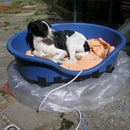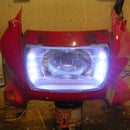Introduction: Motorbike LED Simple Conversion
0HI all!
Now i am sure that most of you know you can buy decent LED replacement bulbs on eBay, that will replace a 21w bulb. However that is not as much fun as building your own units.
Now this is a very simple method using cheap materials. as always i try not to over complicate things,
you need;
-4 8mm 0.5w strawhat LED's per light
-a piece of semi-rigid plastic to cut 35mm discs out of (i.e. ABS)
-soldering iron and solder
-drill and drill bits
-small nut and bolt (M4-M6)
-wood chisel
-heat shrink sleaving 4mm
Step 1: Remove the Light Unit and Dissasemble
Take the unit of the bike (or car!) and strip it down so you can freely acsess the lamp mounting. it is important to note the inside diameter of the collar (not the hole) for later. have a look ahead if your not sure what i mean, as it will become clear.
Step 2: Make a Plastic Disc
We need to make a mounting disc to hold the LED's. I used some ABS plastic conduit box covers i had lying around. They are to big to start with so i needed to machine them down. If you are cutting out of a larger sheet then cut it out over sized and machine it down accurately.
The disc wants to fit into the collar tightly where the original lamp holder screwed in. You want it tight so you don't need to glue or screw in in place.
I screwed down a drill to use it like a lathe. Drill a hole trough the centre of the disc and put a bolt through it and lock it up with a nut. this will act as your arbor. place it in the drill and with the corner of a chisel cut in through the side to get it round, then gently machine it down to i tight fit, test fit it regularly to make sure it fits correctly.
Use the chisel resting on a rest of some sort to help you hold it steady. Cut it slowly and gently, do not rush!!
When machined down and test fitted, score a line where you will drill holes for the LED's. it makes it more accurate than drilling by eye later.
Drill pilot holes in the disc evenly spaced using the line you scored previously. Then drill out to 8mm to take the LED's
Step 3: Mounting and Soldering the LED's
Supporting the plastic disc push the LED's into place, aligning them tall leg to short leg so we can easily wire them up in series.
Twist the tall leg of one LED to the short leg of the next one. do this three times so you leave two legs untouched.
Solder the twists and put some solder on the tops of the two untwisted legs (tinning)
Trim of any bits of leg sticking out of the soldered joints and cover them with small bit of heat shrink sleaving.
Cut the old lamp holder of the wires that join into the bikes wiring.Strip 6mm of the ends, cover them with an dab of solder, place on some heat shrink sleaving and solder to the two legs. Connect the earth/neutral wire to the short leg and the live/positive to the long leg. when soldered cover with the heat shrink sleaving.
Fold down the joined legs to keep them neat, making sure that they don't touch each other.
Test with a 12v supply
Step 4: Assembling the Unit
Push the disc into the collar, it should be a tight fit! make sure it sits in all the way.
Put the unit back together and test it again.
reinstall back on the bike and admire it.
NOTE: unless you already have an electronic flasher relay, the indicators will flash at the wrong speed. this is simple to rectify by swapping your old relay for a electronic/LED relay from eBay.
Step 5: Conclusion
This modification won't make the indicators noticeably brighter, however the will last a very long time and leave them open to further modification like an LED strobe controller to create different effects (for offroad use or hazard warning,ect)
They will also save a little power!!

Participated in the
Make It Glow Challenge













